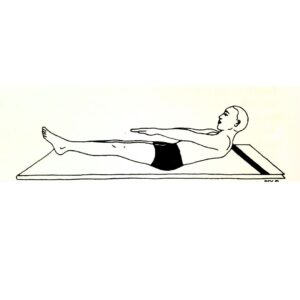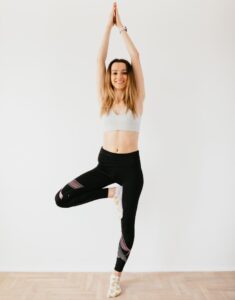Yoga in India is a timeless expression of spiritual discipline that skillfully weaves together the delicate balance of mind and body. It is both an art and a science that promotes overall well-being and is based on ancient knowledge. The name ‘Yoga‘ comes from the Sanskrit word ‘Yuj‘, which means to connect or unite – a profound oneness between individual awareness and the wide expanse of Universal awareness. This alignment, as represented in Yogic teachings, represents perfect harmony not just inside oneself but also with the surrounding universe, exemplifying a symbiotic link between humans and nature.
According to modern theory, the fundamental ideas of yoga align with the ideas of quantum physics, implying that everything in the universe originates from one basic source. When a practitioner internalizes this interconnection, they transcend into a condition known as “yoga” and become a yogi a liberated state also called mukti, nirvana, or moksha. The realization of the Self beyond all types of pain to reach the highest state of liberation known as “Moksha” or “Kaivalya” thus becomes the ultimate aim of yoga. This quest for emancipation pervades all facets of life, promoting liberty, well-being, and peace in all spheres.
In addition, yoga is an internal science that provides a variety of approaches by which people can begin their path toward self-realization and take charge of their own destiny. Its deep origins may be located in the 2700 B.C. Saraswati Valley civilization of the ancient Indus Valley, where it flourished and left an enduring cultural imprint. Over the course of millennia, yoga has persisted in its mission to uplift humanity by promoting both worldly wealth and spiritual enlightenment.
Fundamental human values are embodied in yoga, which acts as a beacon of morality and ethics. It invites practitioners to follow the “Yoga Sadhana” path, where the quest for self-actualization and self-discovery converge harmoniously. Thus, yoga appears as a light in the colorful fabric of India’s cultural legacy. Yoga emerges as a beacon of hope, offering a timeless sanctuary for seekers of inner peace and profound transformation.

History of Yoga in India
Yoga in India is an age-old tradition that dates back to the earliest days of human civilization. Its roots go back thousands of years before belief systems or organized religions became prominent. As per the traditions of yoga, Shiva is considered to be the Adiyogi, the original yogi, and the Adi Guru, the first Guru. It is said that thousands of years ago, on the placid shores of Lake Kantisarovar, which is tucked away in the Himalayas, Adiyogi taught his great wisdom to the fabled Saptarishis, or “seven sages.” With the spirit of this ageless yogic wisdom within them, these sages traveled far and wide, spreading its teachings throughout Asia, the Middle East, Northern Africa, and even South America.
Surprisingly, contemporary researchers have discovered remarkable similarities between ancient societies all around the world, demonstrating the ubiquity of yoga concepts. But the yoga tradition blossomed most abundantly inside the colorful fabric of India. Of all the Saptarishis, Agastya is particularly important since she traveled the length and breadth of the Indian subcontinent. He was the one who had a major influence on how the core principles of yogic living shaped Indian culture.
Yoga in India is more than simply physical poses and breathing techniques; it’s a complete way of life. It leads people toward peace, wellbeing, and self-realization by fusing the spiritual, mental, and physical realms. Millions of people’s lives are impacted by yoga, which is practiced all throughout India, from the sun-kissed beaches of Kerala to the snow-capped peaks of the Himalayas.
The appeal of yoga in India hasn’t waned even in the face of modernity, as more and more people look to age-old knowledge for comfort and direction. It illuminates the way to both inner change and external harmony like a beacon of light. Whether practiced in the solitude of an ashram nestled in the foothills of the Himalayas or amidst the bustling streets of urban India, yoga continues to inspire and uplift, offering a sanctuary of peace in an ever-changing world.

Historical evidences
There is evidence of yoga practice going all the way back to 2700 B.C., the pre-Vedic period. Its lengthy history begins in antiquity and continues into Patanjali’s day. The principal sources of information about Yoga in this historical period are the numerous ancient manuscripts that comprise the Vedas (4 books), Upanishads (108 books), Smritis, the teachings expounded in Buddhism and Jainism, Panini’s scholarly works, the stories contained in the Epics (2 books), and the Puranas (8 books), among other works. These many sources provide priceless insights into the literature and practices surrounding yoga in its early years, shedding light on the practice’s development and importance throughout antiquity.
Development of Yoga in India
- 500 B.C. to 800 A.D. (The Ancient Foundations):-
The term “Classical era” refers to the time roughly between 500 BC and 800 AD, which is considered to have been crucial to the rich development of Yoga. It is notable for having had a significant impact on its history. Notably, important works like Vyasa’s commentary on the Yoga Sutras and the Bhagavad Gita emerged during this period. The teachings of two highly influential leaders in Indian spirituality, Mahavir and Buddha, are especially important during this period. Yoga practice may be traced back to the writings of Mahavir, who articulated the Five Great Vows (Pancha Mahavrata), and Buddha, who formulated the Eightfold Path (Ashta Magga).
The Bhagavad Gita provides a comprehensive development of these principles by describing the pathways of Karma Yoga, Bhakti Yoga, and Gyan Yoga. These routes continue to be excellent resources for anyone looking for spiritual satisfaction and inner serenity. In contrast, Patanjali’s Yoga Sutras provide the basis of our knowledge of yoga, particularly with regard to their description of the Eightfold Path, which forms the core of yogic practice. - 800 A.D. to 1700 A.D. (The Flourishing of Hatha Yoga):- Significant advancements in the field of Yoga occurred in the Post Classical Period, which lasted from 800 to 1700 A.D. During this period, Vyasa’s insightful commentary on the Yoga Sutra came to be, highlighting the mind’s critical role in obtaining equanimity via Yoga sadhana. During this period, there was a strong emphasis on controlling the mind and body, as seen by the teachings of Acharyatrayas (holy persons) such Adi Shankracharya, Ramanujacharya, and Madhavacharya.
In addition, notable figures from this era who made significant contributions to spiritual discourse were Suradasa, Tulasidasa, Purandardasa, and Mirabai. In addition, the Hathayoga tradition developed under the leadership of prominent individuals like Shrinivasa Bhatt, Gheranda, and Swatmaram Suri, who all played important roles in popularizing Hatha Yoga practices. These Yogis included Matsyendaranatha, Gorkshanatha, and Cauranginatha. - 1700 A.D. to 1900 A.D. (Preservation and Revival):- During the Modern era, which lasted from 1700 to 1900 A.D., notable Yogacharyas like Vivekananda, Ramakrishna Paramhansa, Ramana Maharshi, and Paramhansa Yogananda made substantial contributions to Raja Yoga. Several yoga traditions flourished during this time, including Hatha-yoga, Nathayoga, Bhakti yoga, and Vedanta. The fundamental scriptures of Hatha yoga, Gorakshashatakam, Hathayogapradipika, and Gheranda Samhita, explicated Shadanga-yoga, Chaturanga-yoga, and Saptanga-yoga, respectively.
Nowadays, yoga’s effectiveness in conserving, maintaining, and enhancing health is widely acknowledged. The teachings of renowned figures like Swami Shivananda, Shri T. Krishnamacharya, Swami Kuvalayananda, Sri Aurobindo, Maharshi Mahesh Yogi, Acharya Rajanish, Pattabhijois, BKS Iyengar, and Swami Satyananda Sarasvati, among others, are largely responsible for its widespread adoption around the world.



